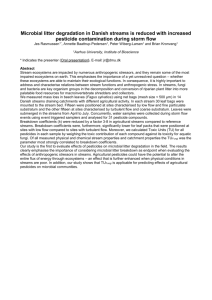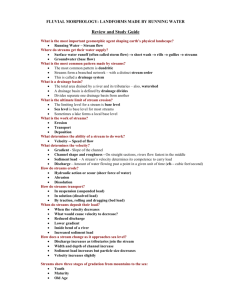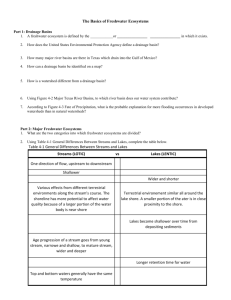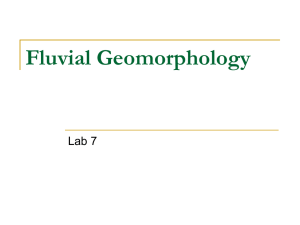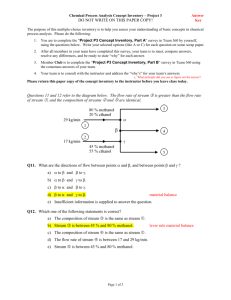File - Jackson Henderson
advertisement
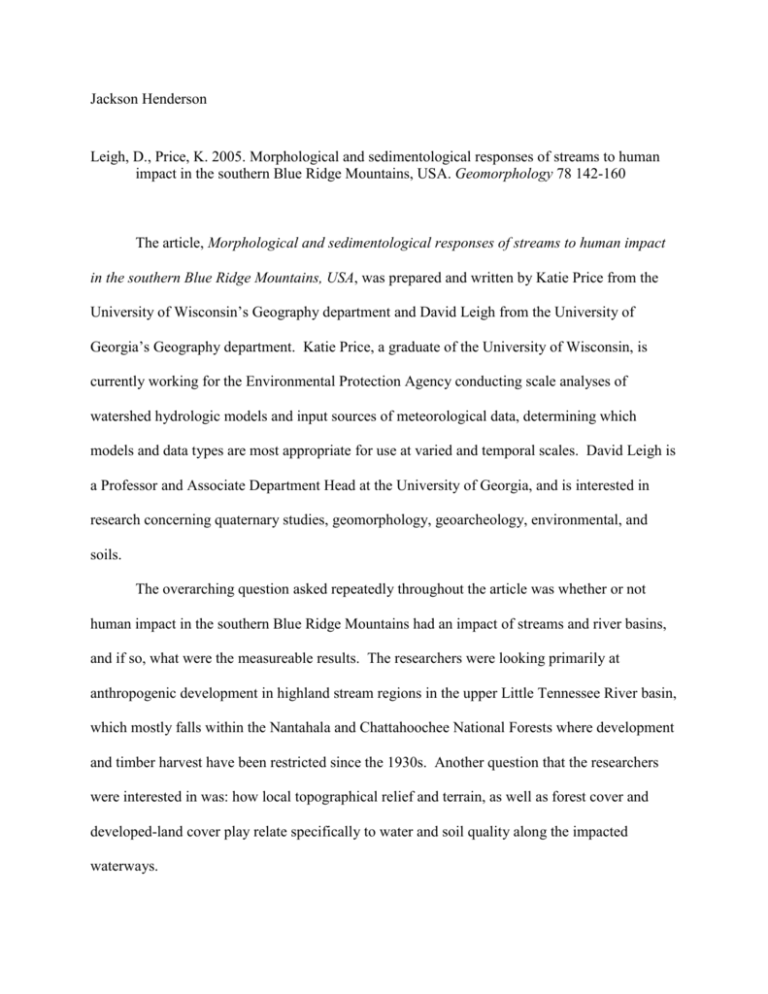
Jackson Henderson Leigh, D., Price, K. 2005. Morphological and sedimentological responses of streams to human impact in the southern Blue Ridge Mountains, USA. Geomorphology 78 142-160 The article, Morphological and sedimentological responses of streams to human impact in the southern Blue Ridge Mountains, USA, was prepared and written by Katie Price from the University of Wisconsin’s Geography department and David Leigh from the University of Georgia’s Geography department. Katie Price, a graduate of the University of Wisconsin, is currently working for the Environmental Protection Agency conducting scale analyses of watershed hydrologic models and input sources of meteorological data, determining which models and data types are most appropriate for use at varied and temporal scales. David Leigh is a Professor and Associate Department Head at the University of Georgia, and is interested in research concerning quaternary studies, geomorphology, geoarcheology, environmental, and soils. The overarching question asked repeatedly throughout the article was whether or not human impact in the southern Blue Ridge Mountains had an impact of streams and river basins, and if so, what were the measureable results. The researchers were looking primarily at anthropogenic development in highland stream regions in the upper Little Tennessee River basin, which mostly falls within the Nantahala and Chattahoochee National Forests where development and timber harvest have been restricted since the 1930s. Another question that the researchers were interested in was: how local topographical relief and terrain, as well as forest cover and developed-land cover play relate specifically to water and soil quality along the impacted waterways. The hypothesis presented by the researchers asked simply if highland land use, involving modest changes in forest cover at the basin-scale, causes significant the sedimentology of stream beds in the four streams of the study area in the Little Tennessee watershed. The four creeks were Coweeta Creek, Skeenah Creek, Keener Creek and Rocky Branch. Leigh and Price presented this hypothesis in the context of past methodologies of studying highly developed areas, but how there was need to study less anthropogenically affected regions of the southern Appalachians. The researchers used a variety of methods to conduct their study, but the majority of their operations were classification studies conducted within GIS and satellite imagery analysis software, using remotely sensed data, as well as in-situ verification and original biological and sedimentological data. Leigh and Price chose two pairs of lightly and moderately impacted basins on the basis of percentage of forested land in the drainage basins. This percentage of nonforested land was treated as an estimator of the percentage of land experiencing human impact. Forest cover in the basins was measured using ArcView and Erdas Imagine software for each year of available data for land cover derived from Landsat satellite imagery and aerial photographs. To isolate human impacts from natural variation, characteristics were established within each pair based on well-documented linkages to channel morphology and sedimentology. A topographic survey of each stream was conducted with at least a 35 meter transect on either side. Each of these extended transects was surveyed using an electronic total station. A Giddings hydraulic coring rig was used to extract 7.5cm diameter cores from key landforms along the extended transect. Soil cores were described according to USDA terminology. Dimensions of the channels were measured at each transect. The height of the channel was defined by measuring the lowest prominent alluvial surface characterized by vertical accretion facies and noted as either a floodplain or a terrace for each side of the stream. Width of the channel was measured at the level of the top of the bank from the lowest alluvial surface, which in in most cases was the floodplain. Baseflow discharge was measured at an optimal transect across each stream on three occasions in October 2003, January 2004, and February 2005. Measurements of flow were limited to frontal, widespread precipitation events in fall/winter months to avoid potential complications arising from the highly localized summer precipitation characteristic of this region. The results of Leigh and Price’s study emphasized consistent, statistically significant differences in both stream pairs. The lightly and moderately impacted streams in this study exhibited significant differences in Baseflow wetted width, baseflow width/depth ratio, dominant particle size in the entire channel bed and riffle (short, relatively shallow and coarse-bedded length of stream) particle size. These conclusions indicate that highland land use, involving modest changes in forest cover at the basin-scale, may cause significant differences in the sedimentology of stream beds. Particle size and embeddedness on riffles have been shown to be linked with the biotic integrity of streams and to be highly sensitive to external disturbance in the southern Appalachians. This paper is important because it reveals and highlights environmental issues of a region of the southern Appalachians not often studied. It discusses human impacts in a place not often thought to have much of an anthropogenic influence. The study shows that human development and impact in these basins has resulted in an overall fining of bed texture but few conclusions can be drawn regarding morphological responses of the streams to the levels of impact affecting the upper Little Tennessee River basin. Widening of channels in response to intensive agriculture and urbanization has been well documented throughout the world, and the modest differences in forest covers between these lightly and moderately impacted basins yield statistically significant differences in morphological parameters. With these concepts and their methods, Leigh and Price showed that the moderately impacted streams are narrower than the lightly impacted streams.
